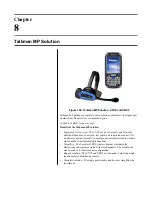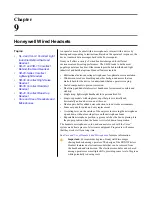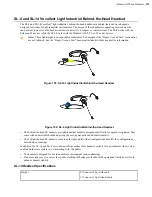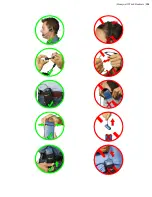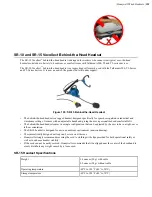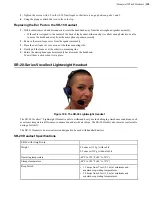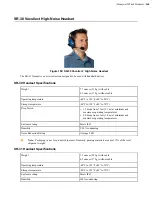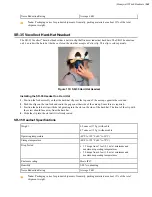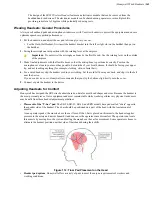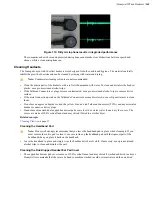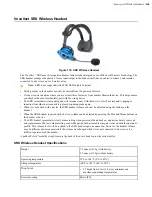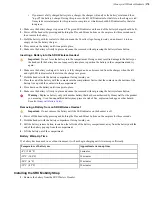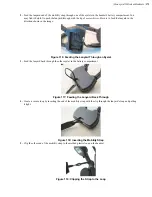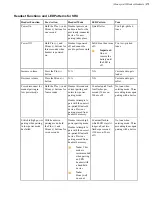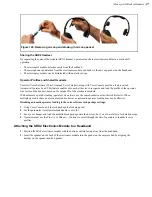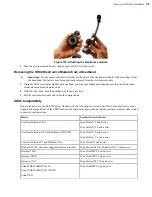
| Honeywell Wired Headsets |
163
The design of the
SRX2 Wireless Headset
features an electronics module that can be removed from the
headband and windscreen. The electronics module can be shared among operators over multiple shifts,
providing some level of hygiene while potentially reducing costs.
Wearing Headsets: General Procedures
Always use headband pads and microphone windscreens with Vocollect headsets to protect the equipment and ensure
optimum speech recognition performance.
1.
Put the headset on and adjust the ear pad to fit snugly over your ear.
• For the Hard-Hat Headset, first insert the headset bracket into the left or right slot on the hardhat, then put on
the hardhat.
2.
Swing the microphone into position with the rotating lever at the earpiece.
Important:
Do not swivel the microphone boom by the flexible end. Use the rotating lever on the outside
of the earpiece.
3.
Make final adjustments with the flexible boom so that the microphone is positioned correctly. Position the
microphone as close to your mouth as possible, but outside of your breath stream. It should be facing your upper
lip, and not touching anything (for example, clothing, skin, or facial hair).
4.
For a wired headset, clip the headset cord to your clothing. Let the cord fall down your back, and clip it to the belt
near the device.
If you use a device cover, Honeywell recommends that you clip the bottom clip directly onto the cover.
5.
Connect or pair the headset to the device.
Adjusting Headsets for Comfort
Honeywell has designed the SR Series headsets based on data for most head shapes and sizes. Because the headset is
the most personal piece of voice equipment and must remain stable while workers perform very physical tasks, users
may benefit from these headset adjustment guidelines.
•
Placement of the "T-bar" pad
: The SR-20, SR-21, SR-30, and SRX models have pads called "t-bars" opposite
the speaker side of the headset. The t-bar should be positioned on a part of the head with the least amount of
muscle.
As an operator speaks, the muscle above the ear flexes. If the t-bar is placed on this muscle, the headset applies
pressure to the artery and nerves beneath it and can cause the operator some discomfort. The operator can locate
this muscle by moving his or her jaw and feeling the area above the ear for movement. Some operators choose to
alternate the headset position on either side of their heads during their shifts.
Figure 112: T-bar Pad Placement on the Head
•
Headset pad options
: Honeywell offers a variety of pads to meet the unique requirements of workers and
working conditions.
Содержание Vocollect
Страница 1: ...Honeywell Vocollect Hardware Reference ...
Страница 2: ......
Страница 4: ......
Страница 12: ......
Страница 20: ......
Страница 36: ......
Страница 80: ......
Страница 106: ......
Страница 128: ......
Страница 148: ......
Страница 150: ......
Страница 154: ... Honeywell Wired Headsets 154 ...
Страница 166: ......
Страница 287: ... Honeywell Regulatory Compliance 287 Japanese Compliance Brazilian Compliance ...
Страница 308: ......
Страница 316: ... Index 316 ...

